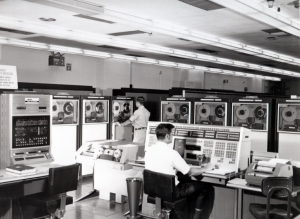 The Automatic Digital Network System began development in the late 1950s as a joint project between IBM, Western Union, and RCA for the US Air Force to centralize communications for its vast number of logistics centers. Built on a network of “switching centers” in strategic locations in the US and Europe, the first site was operational in 1962. Shortly after the system was transferred to the Defense Communications Agency and expanded into 9 centers by the Philco-Ford company. By the late 1960s it connected more than 300 Air Force locations. In the late 80s and early 90s the Philco-Ford processers were replaced with DEC VAX 11/780 series systems. AUTODIN II appeared in 1982 but died in the shadow of the ARPANET and subsequently, MILNET. By the late 90s, AUTODIN was all but phased out.
The Automatic Digital Network System began development in the late 1950s as a joint project between IBM, Western Union, and RCA for the US Air Force to centralize communications for its vast number of logistics centers. Built on a network of “switching centers” in strategic locations in the US and Europe, the first site was operational in 1962. Shortly after the system was transferred to the Defense Communications Agency and expanded into 9 centers by the Philco-Ford company. By the late 1960s it connected more than 300 Air Force locations. In the late 80s and early 90s the Philco-Ford processers were replaced with DEC VAX 11/780 series systems. AUTODIN II appeared in 1982 but died in the shadow of the ARPANET and subsequently, MILNET. By the late 90s, AUTODIN was all but phased out.

tech that changed the world